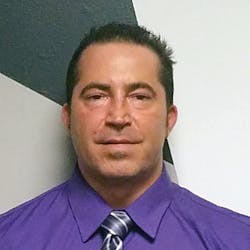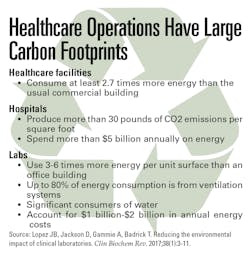The 64-person team at the Kentucky Division of Laboratory Services has been working to reduce its carbon footprint for many years, with a concerted push beginning in 2017. As a result of these efforts, the lab was recognized by the Association of Public Health Laboratories (APHL) as the 2021 Healthiest Laboratory.
The award from the APHL is based on environmental stewardship as well as employee health and wellness, but this article focuses on the lab’s efforts to reduce its carbon footprint. Medical Laboratory Observer interviewed the co-directors, both through written questions and a telephone interview, and provides an edited version of those conversations here.
What motivated your lab to implement green practices?
Johnson: We have some very environmentally conscious staff members at DLS. They tend to take the lead on these projects. We have a small nature sanctuary right outside the lab and that tends to bring deer and other wildlife into the area, which has motivated the staff to help preserve the area and limit actions that would negatively impact the environment. As a lab, we generate so much recyclable waste that throwing it straight into the garbage was not an option. Our staff started the recycling process before the entire building instituted it. Our safety officer and her safety team look for environmentally friendly options for cleaning supplies and laboratory grade reagents. These include bleach alternatives and low impact soap, including phosphatase-free detergents.
What other specific steps has the lab taken to improve its environmental stewardship?
Johnson: There are five separate laboratories, including the Kentucky Division of Laboratory Services, housed in a 30-year-old physical plant. Each laboratory works independently but relies on each other when it comes to building improvements that may impact all tenants. We all share the same airflow and the same plumbing, for example. We share the same problems, but the problems may affect each of us differently.
The overall attitude at our lab is not to be bogged down by things we cannot control but to focus on things we can control or at least influence. We have an extensive recycling (glass, plastic, paper, cardboard, etc.) program throughout the building. There is a carpooling program with neighboring cities that can transport lab workers to their home city and back, limiting carbon emissions. We have several groups of staff members that live close to each other and work out private carpooling agreements to also limit these emissions. DLS purchased and installed a bike rack to support other modes of transportation for employees.
Arora: KY DLS has an energy efficient HVAC system and uses programmable thermostats to conserve heating and cooling costs. We have timed motion sensing lighting in the hallways and several other areas, so energy can be conserved in the less frequently used or low traffic areas. We ensure that solvents are captured in fume hoods, rather than venting into the environment. We limit paper trash by converting many of the files and documents to an electronic system, whenever possible. Our building staff members utilize “green” products for cleaning. The DLS safety officer provides regular indoor air quality tests for contaminants, including formaldehyde and xylene, and provides opportunities for mercury waste to be handled professionally. We also try to make sure that all batteries are disposed of according to regulations from the Environmental Protection Agency. As Matt mentioned, chemical waste is gathered, documented, and removed by an accredited vendor.
Given the fact that you share a common building with the other laboratory tenants, how do you work with them to achieve your goal to become environmentally friendly?
Johnson: We were holding very regular meetings before the COVID pandemic. All of the tenants would be represented from each division, and the building has its own representative. That’s where we discuss some of the major needs and wants and issues in the building. The medical examiner has its issues, and the state police has its issues, and we all come together in the same room, and we talk about them. If we can get one or two of the other divisions on board for something we think is beneficial, we can make a push to get it done.
KY DLS serves as a catalyst for building improvements, spurring other tenants to help with the push to be good environmental stewards. As a tenant in this building, we can only make recommendations and help push for the environmental impact outcomes we desire. For example, we pushed for a more environmentally friendly HVAC system years ago. Though we didn’t get all we sought, we did make it better.
What is the biggest challenge your lab faced regarding green practices during the COVID-19 pandemic, and how did you overcome it?
Johnson: The amount of disposable ‘everything’ being used, and the production of recyclable waste was (and still is) overwhelming. The health crisis response created a tremendous amount of all types of waste. We worked with the building staff to increase the number of pickups that were required for cardboard. We initiated cardboard drop offs to the outside units when building staff were unavailable. Eventually, three large carts were brought into the division to hold all the materials. These carts are picked up weekly, allowing all applicable waste to be gathered, sorted, and removed. The staff worked together to provide Styrofoam drop offs to facilities that accepted them. Overall, it was a team effort to get the recyclables out of the building and to the appropriate facilities.
What are the next steps in your green practices?
Arora: We are currently researching an opportunity to expand, retrofit, or build a new physical plant that will incorporate green practices, which were not utilized when the current facility was built thirty years ago. A new building would provide us with the opportunity to move to some of these modern and environmentally friendly options, such as solar panels; water conservation; rainwater harvesting; building, plumbing, and lighting efficiencies, and a low-energy HVAC system.
The feasibility study will tell us the dollar amount and the pros and cons of staying in the building and fixing it a little bit at a time, or if it would be is it better to just identify another lot of land or another building that is bare bones and can be retrofitted with the newer standards that are used in buildings these days.
We should have that study in the next month or so.What advice can you give laboratorians who are looking to reduce their environmental impact?
Arora: Small incremental steps can go a long way towards a big win. For example, the simple purchase of a bike rack stimulated staff from our division and other building tenants to start riding their bikes to work. Look for different avenues that provide the same services. Don’t take no for an answer when you are trying to improve processes. Take a “no” as “not right now.” Pick your battles. Developing any recycling program is relatively easy to institute. One person can start a trend, and others will typically rally to the movement. For green practices related to the building, initiate conversations with mechanical maintenance and the building superintendent. They know the buildings as well as the weaknesses and limitations and will be your strongest allies. Provide the facts when the initial investments will result in future savings. And again, target your effort towards things you can control or influence.
How would you describe the benefits or your activities?
Arora: These changes and initiatives have tangible and intangible benefits. We know there are monetary benefits, but it is very difficult to put a hard number on them because so many different agencies in the same building are impacted, and other agencies may be paying for particular improvements. Employee morale and pride are some of the greatest intangible benefits. Being recognized as the APHL Healthiest Laboratory has been one of the tangible benefits that has increased the intangible benefit of employee morale for the KY DLS team.




